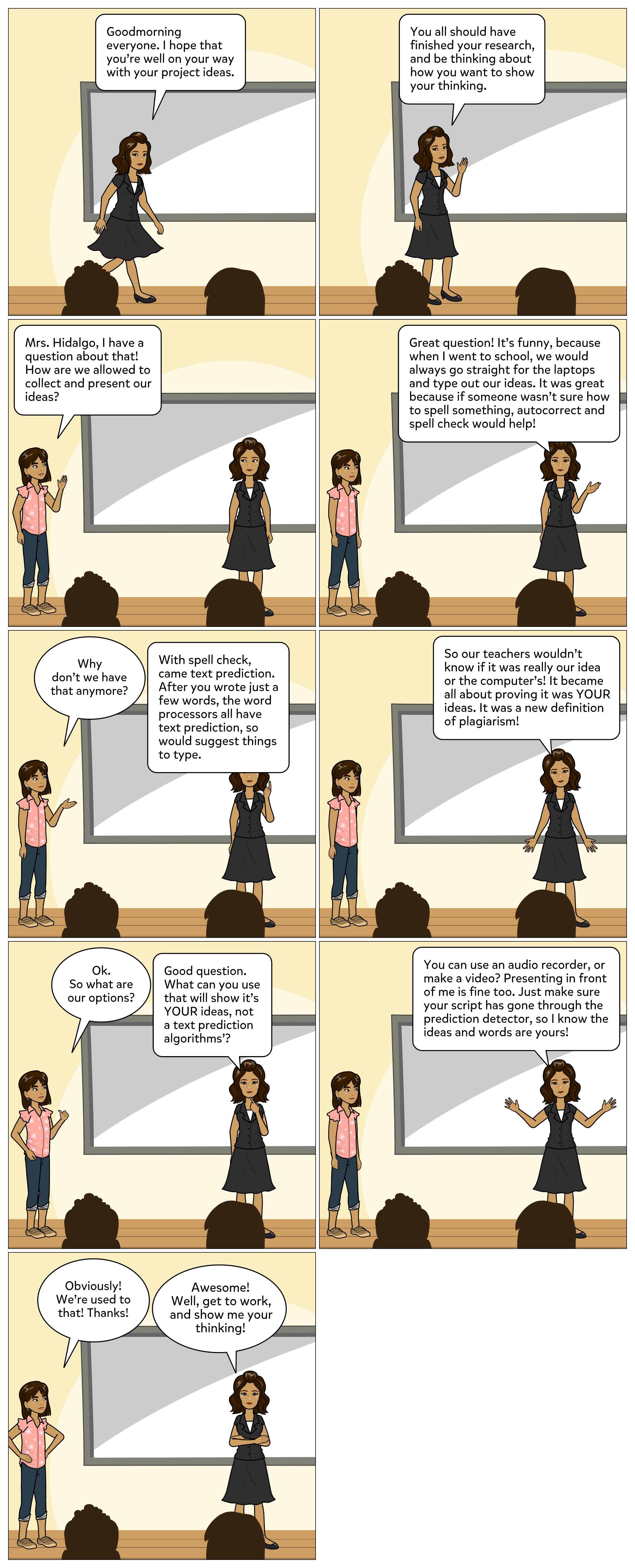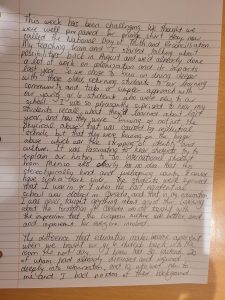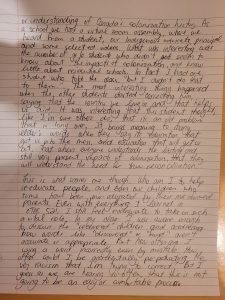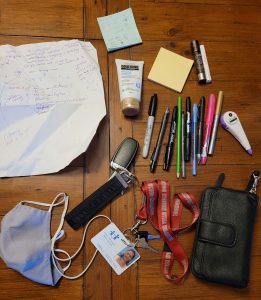For this task I used the “Voice typing” tool in a google doc.
So hey with 2008 and we had my husband Alex and I we are just decided that we were going to buy my childhood home off of my parents it was a huge house 7000 square feet and it we never finished it was actually a dream house by the by the original owner and they’ve never finished it because they ended up getting divorced and oh my gosh there’s a whole story there to I’m so we bought this unfinished 7000 square foot mansion essentially that had been lived in unfinished for over 40 years by a family well over 30 years by family of 7 so it was well used the particle board flooring was black in the kitchen from all this pills there was no paint on the walls there’s literally spare drywall with the taco spots over the screws there’s primer in a couple of rooms but not many are there’s no Cupboards in the kitchen there was no kitchen sink there’s a sink in the laundry room right beside the kitchen counters no kitchen cupboards like it was fair so Alex did I win Diego was about 3 months old start working on this house trying to fix it up it also had had a roof a very leaky roof that caused huge damage the drywall the roof had already been replaced but the tribal hadn’t so there’s a lot of black mold like it was just disgusting and of course my parents are a little bit of Hoarders so there was just a lot of stuff selected building materials old newspapers and magazines and supplies make my dad’s a does a lot with electronic so there’s a lot of like circuits in that kind of thing all around so trying to make this house livable what’s a lot of Blood Sweat and Tears We Were Young we couldn’t afford to have everything paid for it special for buying the house the only thing we actually got professionally done with the windows installed some Plumbing in the basement and the flooring the hardwood flooring on the main floor cuz he did not want to screw that up but all the painting so much of the Woodworking and like building new walls and drywalling and simple electrical like changing out light to not have stuff. We all learn to do ourselves I learned so much in some of those skills are things I’m still using today light this past weekend I was up helping my my friend repaint his house and put in baseboard and do all the caulking on the doors in the door frame of the some of that is still very useful we kept some of the tools that. How sick I learned how to use Diamond saws to cut huge chunks of marble for a fireplace it was really quite is really quite an experience I learned how to cut tile for backsplash though that was the other thing we didn’t do is we did not hang cabinets kitchen cupboards to this day have no idea how with all of the plates and cups you put in them I’ve no idea how they say on the walls and don’t come crashing down so I was way too paranoid to do that by myself so that was something else that we had to professionally done this house by the end was lovely it was such a lovely home once we put in new showers and replace toilets toilets is actually pretty simple. But doing all of these things turning on one of my favourite Pieces by miss beautiful dresser off of Craigslist and refinishing it and cutting into it and I just in the drawers and putting these beautiful vessel sinks in it and it became our Master vanity with double vanity it was beautiful that is definitely one thing when we sold that house a move to Kelowna that we were really sad that we didn’t get to take with us cuz man not piece was beautiful
- How does the text deviate from conventions of written English?
My story certainly deviates from written English conventions in a few ways. There are only a few periods in the entire text (only some of them in the correct place), and a complete lack of other punctuation. There are quite a few places where it capitalized a word incorrectly (Woodworking, Pieces, Blood Sweat and Tears etc). Repetitions were also recorded as I may have repeated myself as I collected my thoughts, but ironically not words like “um”.
- What is “wrong” in the text? What is “right”?
If you studied this text in the way that Ong (2002) talked about, I think you could easily get confused. There were quite a few words transcribed incorrectly, including the first few, which makes understanding my meaning more closely related to detective work than easy study. “So it was 2008” is much easier to understand that what was transcribed “So hey with 2008”. But much of the descriptions of the work we were doing, or the state of the house was accurate. The reader’s brain didn’t have the time to process the information since there were no commas or periods to help chunk the information. So even though much of the story is technically accurate, it is hard to understand and even I took a few times to read through it to understand it enough to see what was ‘off’.
- What are the most common “mistakes” in the text and why do you consider them “mistakes”?
There are many places where the lack of punctuation makes large errors in the text. By not being able to separate ideas by pausing in speech, or by adding punctuation, it became hard to preserve the meanings, connections and separations. There were also times where the computer misheard me and transcribed incorrectly (for example writing “tribal” instead of ‘drywall’) which also adds a layer of detective work to understanding the story. I’m sure another reader could find more mistakes, or places that make it hard for the reader to understand because even as I re-read, I’m able to put the pauses in since I know the story and where it is going. The mistakes that I see are anything that would cause the reader to struggle to understand my intended meaning.
- What if you had “scripted” the story? What difference might that have made?
This reminded me of something that came up when I was doing this week’s readings. Ong talked about being able to study written text and not being able to study oral tellings (2002). Text versions of an oral telling are often very different from the original oral story because how I tell a story, and how I write a story will be different in many ways. When I know a reader won’t be able to hear my tone of voice, expression, or other non-verbal cues, I tend to write in a more descriptive or formal way. And I’m able to add punctuation to emphasize and separate ideas to aid in understanding. If I had scripted this particular story, I likely would have been more specific in some ways to avoid parts of oral speaking that don’t translate well to written text without punctuation, such as side comments or thoughts. I would have been able to put in clearer transitions between ideas to help the reader understand when one thought started and another ended. At the same time, some of the other mistakes would have still been present and made it a challenge to fully understand.
- In what ways does oral storytelling differ from written storytelling?
Oral storytelling to me is much richer, more beautiful and personal than a written story. This comes from the voices, expressions, pauses, volume changes and non-verbal cues that aren’t transferable to a static page and instead rely on the reader to add them in. It’s one of the reasons that one of the Indigenous advocates at our school says that it’s hard to read an Indigenous story, and so much richer to hear it from an Elder as they put in all of those extra pieces to bring the story to life and emphasize the meaning that they are trying to present.
This task has made me wonder if memory has decreased because of the written word. I thought of this because of the example that Boroditsky uses about the innate ability of a group of indigenous Australians who are able to point in any cardinal direction, which is a skill developed based on what was important in that culture. I wonder about Indigenous peoples here on Turtle Island who used oral traditions and stories for their teachings (2011). Would their memories have been much better than the colonizers who relied on written language? I often find it hard to remember details of events or trips unless I’ve jotted something down to remind myself or taken photos. It’s like the story is there, but I depend on written hints or photos to bring it to the forefront. Is oral storytelling a way to practice imprinting stories, lessons, ideas in our heads without being able to rely on “looking things up” later. I feel I remember a story told to me in a different way than something I’ve read.
References:
Boroditsky, L. (2011). How language shapes thought. Scientific American, 304(2), 62-65.
Ong, Walter, J. Taylor & Francis eBooks – CRKN, & CRKN MiL Collection. (2002). Orality and literacy: The technologizing of the word. New York; London: Routledge.










